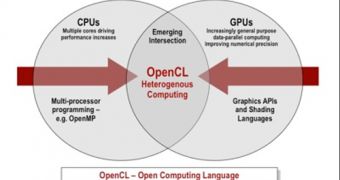The Khronos Group has announced the ratification and public release of the Apple-proposed OpenCL 1.0 - the open, royalty-free standard for cross-platform, parallel programming of modern processors found in personal computers, servers and handheld/embedded devices.
The OpenCL standard was nearly completed in under six months by industry leaders like AMD, NVIDIA, Intel, ARM, 3DLabs, and Qualcomm. OpenCL provides programmers with tools to speed up a wide variety of applications, by taking advantage of untapped GPU processors and multi-core processors found in modern computers.
This should enable developers to take better advantage of existing hardware (GPUs, CPUs) to deliver faster software performance for the end-user. Apple's Mac OS X 10.6 (Snow Leopard) is the first Mac OS to adopt the standard. The new Mac OS is due for release sometime next year, reportedly during the first quarter of 2009.
“The opportunity to effectively unlock the capabilities of new generations of programmable compute and graphics processors drove the unprecedented level of cooperation to refine the initial proposal from Apple into the ratified OpenCL 1.0 specification,” said Neil Trevett, chair of the OpenCL working group, president of the Khronos Group, and vice president at NVIDIA.
“As an open, cross-platform standard, OpenCL is a fundamental technology for next generation software development that will play a central role in the Khronos API ecosystem, and we look forward to seeing implementations within the next year.”
“We are excited about the industry-wide support for OpenCL,” said Bertrand Serlet, Apple's senior vice president of Software Engineering. “Apple developed OpenCL so that any application in Snow Leopard, the next major version of Mac OS X, can harness an amazing amount of computing power previously available only to graphics applications.”
Microsoft is aiming to counter OpenCL with a new version of its own collection of application programming interfaces (APIs) for handling tasks related to multimedia – DirectX. Specifically aimed at game programming and video on Windows platforms, the standard boasts support for “compute shader technology” that allows modern video cards' processors to perform tasks other than rendering video.

 14 DAY TRIAL //
14 DAY TRIAL //